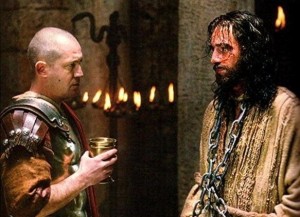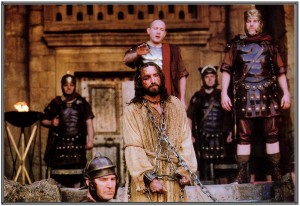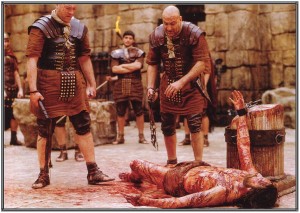In part 1 of this series, the beginning of Christ’s cosmic suffering, that of the Last Supper as well as his time at the Garden of Gethsemane were addressed. Now we move on to the six interrogations and trials of Christ. I am using the term, interrogation for four of the six encounters that Jesus had with the Jewish and Roman authorities, and trials for the other two. The reason for this is that the only time that Jesus actually received what could possibly be considered a trial, was his second appearance before the Sanhedrin, and the last time he appeared before Pilate. Even though these are commonly referred to as trials, the proceedings surrounding these trials (and interrogations) were conducted outside the judicial rules of procedure for both the Jewish court and the Roman court system. The judicial proceedings surrounding Jesus’ conviction and death were initiated by a select number of members of the Jewish Sanhedrin.
 Simon Greenleaf, Professor of Law at Harvard University, succinctly describes the mechanisms employed by the Jewish authorities to accomplish their ultimate goal of having Jesus executed by Pilate: “The accusation of Jesus, instigated by the hatred of the priests and the Pharisees, and presented at first as a charge of sacrilege, but afterwards converted into a political crime and an offence against the state, was marked, in all its aspects, with the foulest acts of violence and perfidy. It was not so much a trial environed with legal forms, as a real passion, or prolonged suffering, in which the imperturbable gentleness of the victim displays more strongly the unrelenting ferocity of his persecutors….Now, if his [Jesus] conduct was reprehensible, if it afforded grounds for a legal accusation, why was not that course taken openly? Why not try him for the acts committed by him, and for his public discourses? Why employ against him subterfuges, artifice, perfidy, and violence? For such was the mode of proceeding against Jesus.”[1]
Simon Greenleaf, Professor of Law at Harvard University, succinctly describes the mechanisms employed by the Jewish authorities to accomplish their ultimate goal of having Jesus executed by Pilate: “The accusation of Jesus, instigated by the hatred of the priests and the Pharisees, and presented at first as a charge of sacrilege, but afterwards converted into a political crime and an offence against the state, was marked, in all its aspects, with the foulest acts of violence and perfidy. It was not so much a trial environed with legal forms, as a real passion, or prolonged suffering, in which the imperturbable gentleness of the victim displays more strongly the unrelenting ferocity of his persecutors….Now, if his [Jesus] conduct was reprehensible, if it afforded grounds for a legal accusation, why was not that course taken openly? Why not try him for the acts committed by him, and for his public discourses? Why employ against him subterfuges, artifice, perfidy, and violence? For such was the mode of proceeding against Jesus.”[1]
Although Professor Greenleaf highlights the physical side of the suffering Jesus underwent during his interrogations/trials, the cosmic suffering is also prominent in his analysis:
Rabbi and Jewish scholar Robert Gordis offers the following context to historical implications that the judicial proceedings of Jesus of Nazareth have had upon the history of the world:
The following is the chronological order of Jesus of Nazareth’s trials/interrogations with commentary:
1) First interrogation—After Jesus’ arrest at Gethsemane, which took place clandestinely around midnight, Jesus is first taken to Annas, (AD 6-15) a former high priest and father-in-law of Caiaphas, who was the current high priest—John 18:12-14; 19-23. According to the Talmud, the Sanhedrin is forbidden from convening between the time of the evening and morning sacrifice. In the book, Jesus Before the Sanhedrin, M.M. Lemann states that “no session [including a preliminary examination] of the court could take place before the offering of the morning sacrifice.” Furthermore, “An accused man was never subjected to private or secret examination,” as stated in Institutions de Moise, by J. Salvador. [4] From the very beginning we see that the “Jewish laws of procedure were grossly violated.”
Annas first asks Jesus about his disciples and his teaching. This would indicate that the primary concern was theological, although political charges would be added later on to force Pilate’s hand. The high priest then questioned Jesus about his disciples and his teaching. Jesus answered him, “I have spoken openly to the world. I have always taught in synagogues and in the temple, where all Jews come together. I have said nothing in secret. Why do you ask me? Ask those who have heard me what I said to them; they know what I said.” When he had said these things, one of the officers standing by struck Jesus with his hand, saying, “Is that how you answer the high priest?” Jesus answered him, “If what I said is wrong, bear witness about the wrong; but if what I said is right, why do you strike me?” Annas then sent him bound to Caiaphas the high priest. (John 18:19-24 ESV) Jesus answers the first question from Annas comprehensively, first testifying to the openness of his ministry and teaching, and then wisely referring Annas to the eyewitness testimony of those who heard his teaching. It was as if Jesus was giving Annas every opportunity to conduct his inquiry according to the proper judicial and investigative procedures. Annas however rejects Jesus’ suggested course of action, and instead, responds with violence. Jesus is struck in the face and thus begins His physical harm and cosmic suffering, that of public humiliation.
In John’s eyewitness account, Peter’s denial is also highlighted. This is one of the many reported events that correspond to the historical criteria of embarrassment. Considering that Peter would become one of the primary leaders of the Christian fellowship in Jerusalem and of the early church, it is unlikely that early Christians would have invented a story of their leader’s apostasy and denial of Jesus if it had not happened, thus adding credibility to John’s narrative. 2)
2) Second interrogation— Jesus is then sent to Caiaphas’ house where the men guarding him abuse him by mocking and beating Him and spitting and berating him, hence, adding to His physical suffering and more importantly, humiliation. At this interrogation Jesus is blindfolded and Caiaphas’ men continue to assault him with insults and questions—John 18:22; Matt. 26:57-68; Mark 14:53-65; Luke 22:54, 63-64 This interrogation was nothing more than thuggery, a gathering for one purpose and one purpose only, that of humiliating the subject.
3) Third interrogation—At daybreak the Sanhedrin reconvened. Although Matthew 26:59 states that Jesus appeared before “the whole council” (“Sanhedrin”), this need not denote all 70 members but may simply indicate those hastily assembled in the middle of the night (23 members made a quorum). [5] It was at this time that Jesus was questioned regarding who he was, at which time he confirms that he is the Son of God—“Again the high priest asked him, “Are you the Christ, the Son of the Blessed?” And Jesus said, “I am, and you will see the Son of Man seated at the right hand of Power, and coming with the clouds of heaven,” applying to Himself the messianic prophecies of Psalm 110:1 and Daniel 7:13-14. (Mark 14:61-62) With this declaration the council concludes that Jesus should be put to death for blasphemy—Luke 22:66-71; Matt. 27:1-2; Mark 15:1; John 18:28. 
Hilarin Felder sheds more light on the judgment the Pharisees actually impose on themselves:
4) Fourth interrogation—The leaders of the Sanhedrin now take Jesus to Pilate. They know that the charge of blasphemy will not sway Pilate, so other charges are concocted. First of all, subversion; “We found this man misleading our nation…He stirs up the people, teaching throughout all Judea, from Galilee even to this place.” (Luke 23:2, 5); opposed paying taxes to Caesar; “forbidding us to give tribute to Caesar…” (Luke 23:2)—this accusation was false, and the Pharisees knew it, as is borne out in the exchange that Jesus had with the Pharisees earlier on in his ministry regarding paying taxes, when the Pharisees “plotted how to entangle him in his words.” Jesus astonished them with his reply to “render to Caesar the things that are Caesar’s, and to God the things that are God’s.” (Matthew 22:15-22); proclaimed Himself as King of the Jews; at first blush, Pilate does not take this claim seriously, after all, why should he. To him, Jesus in no way appeared to be a king, he had no earthly power, no army, etc. To Pilate, Jesus was simply a delusional Jewish ‘holy man’ of no significance to Rome. Unconvinced that Jesus is any threat to the Roman government, he hears that Jesus is from Galilee and sends Him to Herod Antipas.
5) Fifth interrogation—Herod and his soldiers mock Jesus, and the chief priests and the scribes stood by “to [vehemently] accuse him, saying, “We found this man misleading our nation and forbidding us to give tribute to Caesar, and saying that he himself is Christ, a king.” (Luke 23:2) As with Pilate, Herod is not convinced that Jesus is a threat and sends Him back to Pilate—Luke 23:6-12
6) Sixth interrogation—The six interrogation/trial begins with Pilate once again questioning Jesus. “Pilate answered, “Am I a Jew? Your own nation and the chief priests have delivered you over to me. What have you done?” Jesus answered, “My kingdom is not of this world. If my kingdom were of this world, my servants would have been fighting, that I might not be delivered over to the Jews. But my kingdom is not from the world.” Then Pilate said to him, “So you are a king?” Jesus answered, “You say that I am a king. For this purpose I was born and for this purpose I have come into the world—to bear witness to the truth. Everyone who is of the truth listens to my voice.” Pilate said to him, “What is truth?” After he had said this, he went back outside to the Jews and told them, “I find no guilt in him.” (John 18:35-38 ESV) Pilate attempts to appease the chief priests, and the crowd that they were stirring up, by having Jesus flogged.
To understand the extent of Christ’s physical suffering and humiliation at the hands and will of man, a comprehensive look into what a Roman flogging entailed is essential. The utter humiliation, pain and agony that was part of a Roman flogging, is, for the most part, incomprehensible in today’s world. I will turn now to those who have undertaken to describe the brutality and severity of that which Christ was subject too.
Dr. Frederick Zugibe states:
Medical doctor Thomas A. Miller states:
A Roman flogging was referred to as the pre-death. The point of the flogging was to so weaken the person so that they could not fight against the mechanics of crucifixion, that of pushing their body up with their legs so as to allow them to keep breathing, thus the Romans breaking the legs of the two malefactors who were obviously still alive, but only piercing Jesus’ side to confirm that he was indeed dead. The severe scourging, with its intense pain and appreciable blood loss, most probably left Jesus in a pre-shock state. Moreover, hematidrosis had rendered his skin particularly tender. The physical and mental abuse/humiliation meted out by the Jews and the Romans, as well as the lack of food, water, and sleep, also contributed to his generally weakened state. Therefore, even before the actual crucifixion, Jesus’ physical condition was at least serious and even critical.
Dr. Thomas A. Miller continues:
Dr. Frederick Zugibe adds the following regarding the crown of thorns:
Now we return to the second stage of Jesus’ trial before Pilate: “Pilate went out again and said to them, “See, I am bringing him out to you that you may know that I find no guilt in him.” So Jesus came out, wearing the crown of thorns and the purple robe. Pilate said to them, “Behold the man!” When the chief priests and the officers saw him, they cried out, “Crucify him, crucify him!” Pilate said to them, “Take him yourselves and crucify him, for I find no guilt in him.” The Jews answered him, “We have a law, and according to that law he ought to die because he has made himself the Son of God.” When Pilate heard this statement, he was even more afraid. He entered his headquarters again and said to Jesus, “Where are you from?” But Jesus gave him no answer. So Pilate said to him, “You will not speak to me? Do you not know that I have authority to release you and authority to crucify you?” Jesus answered him, “You would have no authority over me at all unless it had been given you from above. Therefore he who delivered me over to you has the greater sin.” From then on Pilate sought to release him, but the Jews cried out, “If you release this man, you are not Caesar’s friend. Everyone who makes himself a king opposes Caesar.” So when Pilate heard these words, he brought Jesus out and sat down on the judgment seat at a place called The Stone Pavement, and in Aramaic Gabbatha. Now it was the day of Preparation of the Passover. It was about the sixth hour. He said to the Jews, “Behold your King!” They cried out, “Away with him, away with him, crucify him!” Pilate said to them, “Shall I crucify your King?” The chief priests answered, “We have no king but Caesar.” So he delivered him over to them to be crucified. (John 19:2-16 ESV)
 Simon Greenleaf offers the following legal analysis in regards to Pilate’s acquiescing to the will of the Jewish authorities, and thus reversing his pronouncement of innocence of Jesus in regards to all charges brought before him:
Simon Greenleaf offers the following legal analysis in regards to Pilate’s acquiescing to the will of the Jewish authorities, and thus reversing his pronouncement of innocence of Jesus in regards to all charges brought before him:
In part 3 of this series, we will conclude our examination of Christ’s cosmic suffering, via the crucifixion and the physical, mental and spiritual anguish that he suffered before his death. (For part 1 of this series, here)
(You can also contact the author of this article at: 4Lane.davis@gmail.com)
[1] Simon Greenleaf, An Examination of the Testimony of the Four Evangelists, by the Rules of Evidence Administered in Courts of Justice—With an Account of the Trial of Jesus, pgs. 894, 895, 1847
[2] Linton, Irwin H., The Sanhedrin Verdict, New York; Loizeaux, 1943, pg. 7
[3] Robert Gordis, Forward, 20 Judaica 6, (1971)
[4] 12 Reasons Jesus’ Trial Was Illegal, Pt. 1, http://rcg.org/pillar/0902pp-trjtwi.html
[5] ESV Study notes
[6] Hilarin Felder, Christ and the Critics, Trans. John L Stoddard, London: Burns, Oates & Washburn, 1924, pg. 306
[7] Jahn’s Bibl. Ant. § 246
[8] Thomas A. Miller, MD, Did Jesus Really Rise from the Dead, Crossway, 2013, pg. 71
[9] Ibid, An Examination of the Testimony of the Four Evangelists, pg.870-71
The Trial of Jesus-Historicity Affirmed-Inspiring Philosophy









